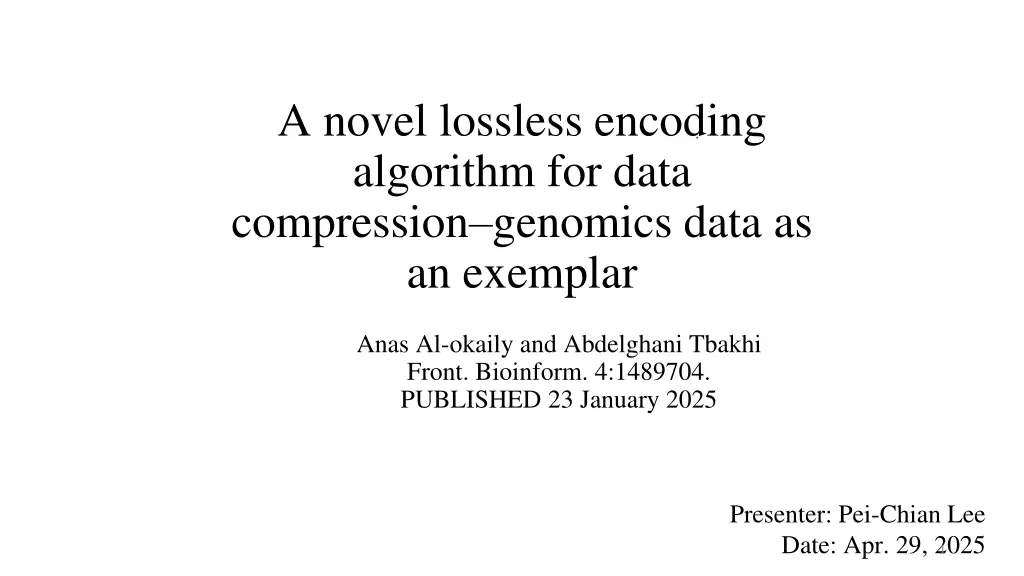
Novel Lossless Encoding Algorithm for Genomics Data Compression
Explore a novel lossless encoding algorithm for efficient data compression in genomics, utilizing a divide-and-conquer approach to categorize and compress data, showcasing significant improvements in genome compression and potential applications across various data types.
Download Presentation

Please find below an Image/Link to download the presentation.
The content on the website is provided AS IS for your information and personal use only. It may not be sold, licensed, or shared on other websites without obtaining consent from the author. If you encounter any issues during the download, it is possible that the publisher has removed the file from their server.
You are allowed to download the files provided on this website for personal or commercial use, subject to the condition that they are used lawfully. All files are the property of their respective owners.
The content on the website is provided AS IS for your information and personal use only. It may not be sold, licensed, or shared on other websites without obtaining consent from the author.
E N D
Presentation Transcript
A novel lossless encoding algorithm for data compression genomics data as an exemplar Anas Al-okaily and Abdelghani Tbakhi Front. Bioinform. 4:1489704. PUBLISHED 23 January 2025 Presenter: Pei-Chian Lee Date: Apr. 29, 2025 1
Abstract (1/2) Data compression is a challenging and increasingly important problem. As the amount of data generated daily continues to increase, efficient transmission and storage have never been more critical. In this study, a novel encoding algorithm is proposed, motivated by the compression of DNA data and associated characteristics. The proposed algorithm follows a divide-and-conquer approach by scanning the whole genome, classifying subsequences based on similarities in their content, and binning similar subsequences together. The data is then compressed into each bin independently. This approach is different than the currently known approaches: entropy, dictionary, predictive, or transform-based methods. Proof-of-concept performance was evaluated using a benchmark dataset with seventeen genomes ranging in size from kilobytes to gigabytes. 2
Abstract (2/2) The results showed a considerable improvement in the compression of each genome, preserving several megabytes compared to state-of-the-art tools. Moreover, the algorithm can be applied to the compression of other data types include mainly text, numbers, images, audio, and video which are being generated daily and unprecedentedly in massive volumes. 3
OST-DNA TCCGA .. CCAGT 4
OST-DNA compression T = "GATCGTCGTACCGATCGTATGTCGA w = 5 label length = 4 L = {bin_A, bin_B, bin_C,bin_B, bin_A} -> huffman algorithm G:0 A:10 T:110 C:111 subseq Label bin GATCG GATC_1233 bin_A TCGAT TGCA_1233 bin_B CCGAT CGAT_1233 bin_C CGTAT TGCA_1233 bin_B GTCGA GATC_1233 bin_A bin_A: {GATCG, GTCGA}-> other compression algorithm bin_B: {TCGAT, CGTAT}-> other compression algorithm bin_C: {CCGAT}-> other compression algorithm 5
OST-DNA decompression L = {bin_A, bin_B, bin_C,bin_B, bin_A} bin_A: {GATCG, GTCGA} bin_B: {TCGAT, CGTAT} bin_C: {CCGAT} T = " GATCGTCGTACCGATCGTATGTCGA 6
Key Points of the OST-DNA Algorithm 1. This design facilitates organizing and sorting the input datausing a divide-and- conquer method by creating bins for similar data and encodes/compresses data in the same bin that are better if compressed together, to achieve better compression results with a minor increase in time costs. 2. Bin labels are computed using a Huffman tree encoding. The reason for selecting Huffman algorithm since the label of larger bin must be more frequent in L, hence encode this label with shorter codes (while the label of smaller bins with longer codes). L = {bin_A, bin_B, bin_C,bin_B, bin_A} -> huffman algorithm bin_A: {GATCG, ATCGA} bin_B: {TCGAT, CGTAG} bin_C: {CCGAT} 7
Result 8
Complexities compression : O(t) decompression : O(t) 9
